Pass Labs X250 Two-Channel Power Amplifier August, 2002 John E. Johnson, Jr.
|
 Introduction
Introduction
Although Pass Labs, via Nelson Pass, has only been around for about a
decade, they have garnered more awards than many companies who have been
around a lot longer. The formula for that success is simple, namely . . .
quality. Pass' first designs, in the Aleph line, were single-ended pure
Class A solid state.
A few years later, the Aleph series was replaced with the X series, of which the X250 reviewed here is a member, and they are about to release the new XA amplifiers which have more Class A power than the X series. The X and XA series have much more power than the old Alephs, partially due to being balanced designs.
All of this comes at a high price, but Pass has never been anything but a high performance manufacturer. The power supply is the most expensive part of an amplifier, and the power supply in the X250 is massive, having a 1.2 kVA toroidal transformer, and twenty 10,000 �F capacitors with � 47 Volts, which provides 221 Joules of energy storage. That is why it doubles its output power from 250 watts into 8 Ohms to 500 watts into 4 Ohms. And, this is with some bias into Class A (the power consumption at idle is 270 watts, which suggests about 25 watts of Class A for each channel).
The Design
The front panel is a thick machined aluminum plate, with an On/Off button, above which is a blue backlit meter that indicates how much power is being output. The meter does not have numeration, but rather, just indicates a general output. A small blue LED at the top of the meter stays lit even at power off, to indicate standby. There is a second power toggle on the rear panel, which will completely shut off power (when you go on vacation), and which will also trip in the case of a power fault.

Speaker connectors are made for spade lugs or bare wire wrap only. There is no means for inserting banana plugs. Because our test cables are all banana plug terminated, I looked all over the Internet for adapters. I found only a few available, but they were gold plated and seemed to work fine. One was a $1.50/pair lug that I needed to pry open the socket so a banana would fit. The other one, which I think is the best of the two that I tried, is a much more solid lug that is specifically designed as a spade/banana adapter. It is called a Home Theatre Block Type Spade Terminal to Banana Jack, No. 45-282G, made by LKG Industries, Rockford, Illinois, and is available from Cables & Connectors, Inc. (http://www.cablesandconnectors.com), their catalog # 25587, for $6.99 a pair. You need two pairs for the amplifier. A close-up of the adapter in use is shown in the second photo below.
The panel includes both RCA unbalanced and XLR balanced inputs. The amp comes with a small U hook inserted into the XLR inputs for use when RCA connections are made. To use the XLR, you take a small pair of pliers and remove the hooks. (Keep them in a safe place.) The bottom right corner of the panel has a pair of connectors for trigger by other products, like a preamplifier. The grounded AC socket accepts whatever power cord that might suit your fancy. The one that came with the X250 was fine for me.
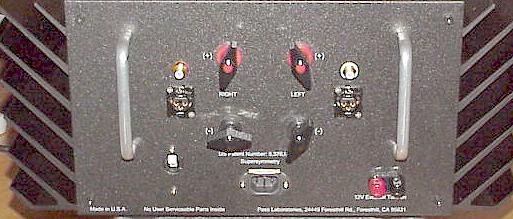
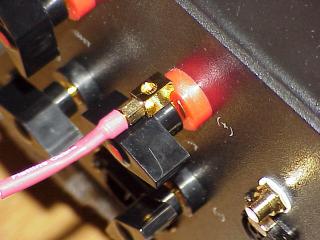
The inside of the X250 chassis is a sea of Mosfet output devices. There are 16 Mosfets for each channel. This is another reason, besides the power supply, that this amp doubles its output power into 4 Ohms. You can also see from the photo below, how big the heat fins are. I never experienced the amplifier getting very warm, and I guess this is why. You would be surprised at how expensive big fins like this are to manufacture. Again, there really isn't anything but top notch parts and construction on the Pass product.
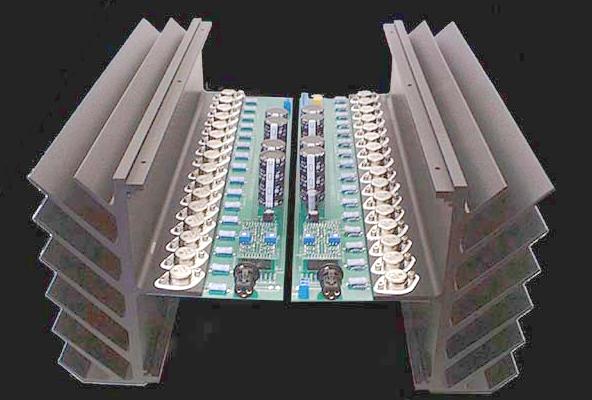
The X250 has a single-ended but balanced input stage, and balanced output stage that ties the outputs of the two halves of the balanced circuit together in such a way (Pass Supersymmetry� ) that 99% of the distortion is canceled out. As a result, very little negative feedback is used in the output stage. There are only two gain stages, the input and the output. This means that the input stage has to be driven very hard, and this is one reason a big power supply is actually required, rather than just being a choice.
Block Diagram
Pass states that the X250 has a single-ended balanced design. Normally, these two terms are mutually exclusive, so here is a way it might be done (diagram below). The input stage, shown on the left, has two single amplifier circuits that are mirror images of each other, and referenced to ground. They are tied together at a point where the voltage is zero, and as a result, could be called single-ended, and would be required to run in pure Class A, meaning that the entire sine wave has to be carried by each circuit. The output stage, shown on the right, has two push-pull circuits that are, again, mirror images of each other. This is a fully balanced circuit. They are tied together at a point where the voltage is zero, but because they are two push-pull circuits, they are not considered single-ended, and they do not have to be run in pure Class A. So, only half the sine wave is carried by each circuit. Tying them together allows a greater cancellation of common mode noise.
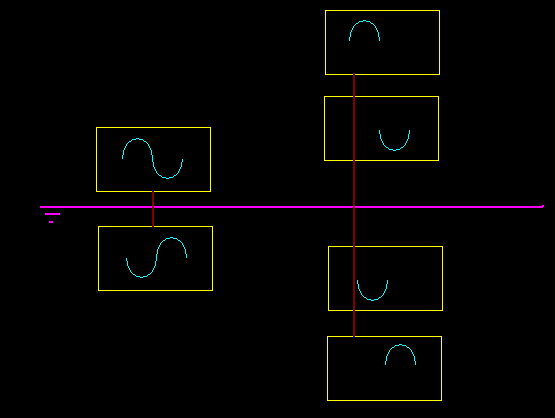
The Sound
I tested the X250 with our Theta Casablanca Processor and Threshold ES-500 Electrostatic Speakers. BetterCables and Nordost cables connected everything together. We used the system in a balanced configuration.
You might think that a high-performance product like this is overkill in a surround sound system, but it is not so. These days, we have DVD-A and SACD to contend with, as well as DTS surround CDs. Also, the sound tracks on movies are getting really good. So, I had no qualms about putting the X250 into our lab grade home theater.
The first thing I was struck by was the effortless way the X250 drove our full range electrostatics. The meter on the front hardly moved even at high volume. The X250's humongous power supply is perfect for difficult loads like ESLs.
Some of my current favorite discs are the 96/24 music DVDs that are manufactured by Hi-Res Music. Specifically, they are old jazz master tapes that have been converted to digital format. Two guitarists alternate playing solos, or play main themes simultaneously, and it takes a fine amplifier to get all this info out to the listener, which is exactly what the X250 did in my listening environment. The combination of 96/24 and the Mosfet output stage of the X250 made music that sounded like an LP, which is a compliment by the way. Of course, that is without any scratches, pops, or clicks.
The background of the X250 is very, very quiet. No hiss or hum. That is critical with today's 24 bit dynamic range.
We used the X250 as the front left/right channels in many of our DVD movie watching sessions, and a noticeable amount of edginess that was there previously, had disappeared. Mosfet designs are sooooo nice for this kind of thing. From the machine gun crackles in "Pearl Harbor", to the pod race in "Star Wars I", the X250 was pleasure of the extreme kind. Adding two more X250s to handle the complete surround sound experience would make a home theater fit for any taste.
The X250 plays really loud too, without any problems. I suspect Pass has gone to big amps for the big sound tastes that we have all acquired from watching big sound tracks. And the X250 is their smallest amp in this line.
On the Bench
Both the 1 kHz and 11 kHz - 12 kHz (IMD) tests showed excellent results (photos below). At - 30 dB, the distortion is less than 0.03% for 1 kHz and less than 0.02% for 11 kHz - 12 kHz. Notice that going to a higher output level, i.e., - 20 dB, the distortion for both tests goes down. This is rather typical for many designs, with distortion being higher at very low output levels. In any case, the distortion at - 20 dB (about 2.5 watts) approaches the limits of our test system. With many amplifier designs that use low to no negative feedback, the distortion would be higher than this. The low values here are testimony to Pass' symmetrical balanced design, which has as one of its primary goals, the reduction of distortion without having to use much negative feedback.


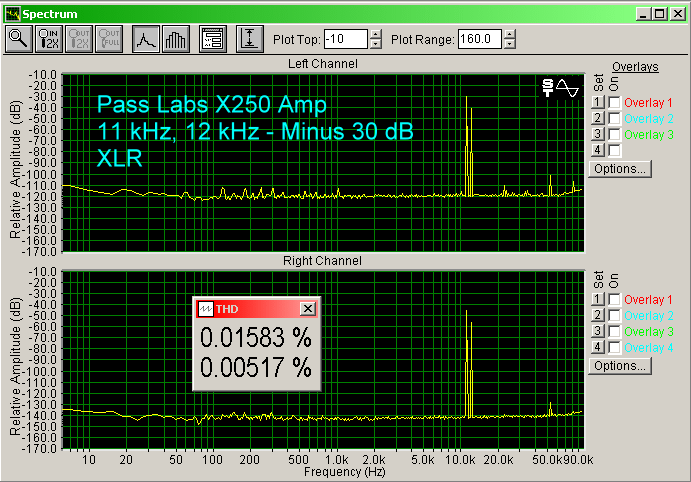
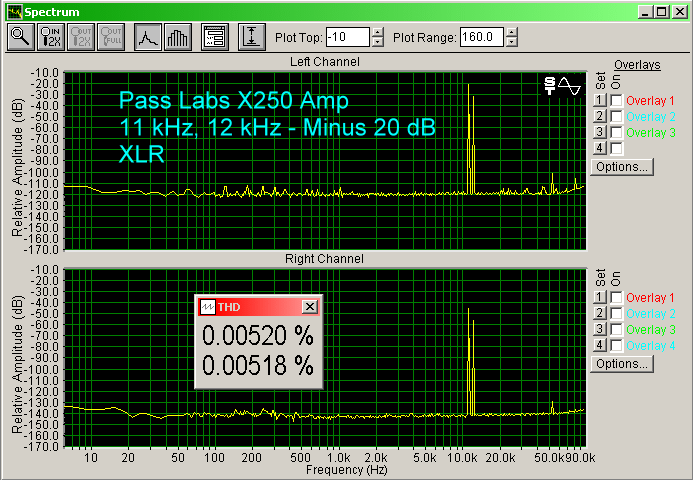
The frequency response is shown below. The response is ruler-flat at the low end, and begins rolling off at 3 kHz, to be - 3 dB at 90 kHz, which is pretty much what Pass specifies. Adding negative feedback would smooth off the response so that it is flat all the way through the audible band, but this would affect the sound in a way that is contrary to the Pass goals. The existing response will indeed cause some phase shift in the audible band, but that is a compromise that Pass is willing to make in order to avoid adding other artifacts.
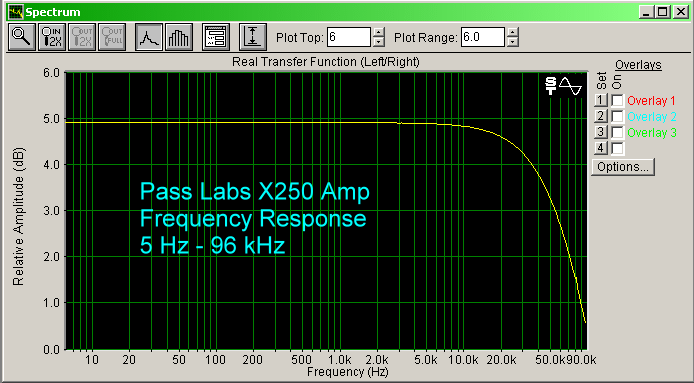
Conclusion
The Pass X250 has all of the design characteristics that make a fine amplifier: massive power supply, only two gain stages, minimum use of negative feedback. The addition of their proprietary Supersymmetry adds a low distortion spec that other designs have difficulty achieving when such minimal amounts of negative feedback are used. The result is a very fine product that looks great, sounds great, is built like a tank, and will last into the far, far beyond.
- John E. Johnson, Jr. -
|
Related to the article above, we recommend the following: |
|
| The Importance of the Power Supply | What we Hear |
| Accuracy, Distortion, and the Audiophile | |
|
� Copyright 2002 Secrets of
Home Theater & High Fidelity |
 |
![]()



